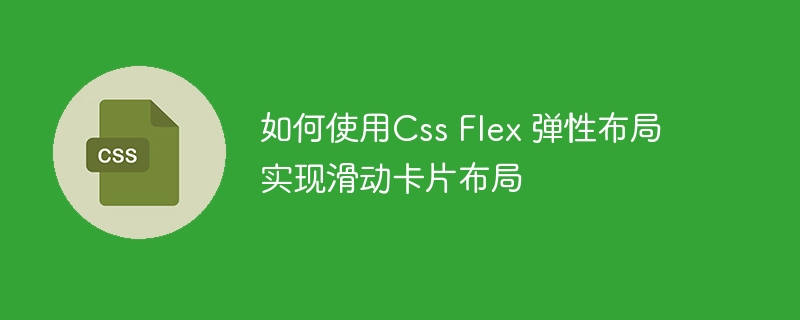

How to use Css Flex Flexible Layout to implement sliding card layout
In modern web development, flexible layout (Flexbox) has become more and more popular. It is a CSS module for positioning and layout elements that can easily achieve various complex layout effects. This article will introduce how to use Flex elastic layout to implement sliding card layout and provide specific code examples.
Sliding card layout is a common UI design pattern, often used to display images or content. Each card can be switched to the next by swiping or tapping. In this layout, the cards are usually arranged horizontally, showing a complete card, and only one card at a time.
First, we need a parent container that contains all cards. Using Flexbox layout, we will set the container to be a flex container and specify the direction of the main axis to be horizontal. Next, we will create a child element for each card and place them in the parent container. Let’s take a look at the specific code example:
HTML code:
<div class="card-container"> <div class="card">Card 1</div> <div class="card">Card 2</div> <div class="card">Card 3</div> <div class="card">Card 4</div> </div>
CSS code:
.card-container {
display: flex;
flex-direction: row;
overflow-x: scroll;
scroll-snap-type: x mandatory;
}
.card {
flex: 0 0 100%; /* 每个卡片的宽度为父容器宽度 */
scroll-snap-align: start; /* 卡片以卡片容器的起点对齐 */
padding: 20px;
background-color: #f0f0f0;
border-radius: 10px;
margin-right: 20px;
}In the above code, we first add .card- container is set to a flex container, and the flex-direction property is set to row, which means the cards are arranged horizontally. To achieve the sliding effect, we set overflow-x: scroll, which will enable a horizontal scrollbar when the container is wider than the parent container. We also use scroll-snap-type: x mandatory to enable the scroll snap effect to ensure that only one complete card is displayed each time you scroll.
For each card, we use flex to specify that the width of the card is the width of the parent container. Using the scroll-snap-align: start property, we align the starting point of each card to ensure they are always displayed in their complete form. At the same time, we can beautify each card by adding appropriate styles and content.
The above code is just a basic example, you can add more styles and interactive effects as needed. For example, add buttons to switch to the next card, implement transition effects, and more. Additionally, you can place more content inside the card, such as images, text, or other elements.
Summary
This article introduces how to use CSS Flex elastic layout to implement sliding card layout. By using a flex container and setting appropriate styles and properties, we can easily implement this common UI design pattern. Flexbox layout provides a simple and powerful way to organize and arrange elements, allowing us to create a variety of complex layout effects.
Hope this article can provide you with some valuable information to help you implement sliding card layout using Flexbox layout. If you have any questions or suggestions about this, please feel free to ask and share.
The above is the detailed content of How to use CSS Flex elastic layout to implement sliding card layout. For more information, please follow other related articles on the PHP Chinese website!




